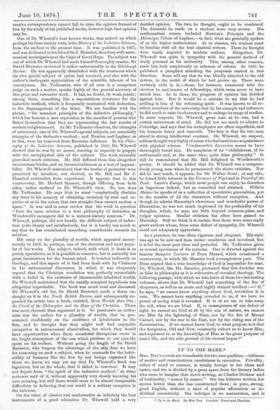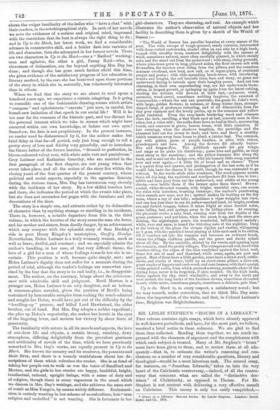UP TO THE MARK.* Mits. DAY'S novels are remarkable for
two rare qualities, —loftiness of motive and conscientious carefulness in execution. Frivolity, either of mind or manner, is totally foreign to her ideas and tastes, and she is divided by a great space from the literary ladies who seem to imagine that novel-writing, as Charles Dickens said/ of husbandry, "comes by nature." She has hitherto written her. stories better than she has constructed them ; in pure, strong, good English, without a taint of popular affectation or in- dividual eccentricity. She indulges in no mannerisms, and is
• Up to the Mark. By Mrs. Day. London: Hurst end Blackett.
above the vulgar familiarity of the ladies who "have a chat" with their readers, in the autobiographical style. In each of her novels we note the evidences of a serious and original mind, impressed with the conviction that its best is always the right thing to do ; and in Up to the Mark, her latest work, we find a considerable advance in constructive skill, and a bolder dash into varieties of life and character, than she attempted in her former novels. There are two characters in Up to the Mark—one a" Radical" working- man and agitator, the other a girl, Fanny Reid—who, in cleverness of delineation, are far beyond anything Mrs. Day has done ; and though she has gone much farther afield this time, she gives evidence of the satisfactory progress of her education in literary method, by the care she has bestowed upon those portions of the story in which she is, naturally, leas vehemently interested than in others.
When we find that the story we are about to read opens a hundred years ago, we experience a certain misgiving. Is it going to resemble one of the fashionable drawing-rooms which artists "compose" and upholsterers " execute " just now, in careful, but brand-new imitation of that epoch in our social life? Will it be too near for the romance of the historic past, and too distant for the personal interest which we take in scenes which might have occurred within our own knowledge, or before our own eyes? Somehow, the date is not propitiatory. In the present instance, no reader need be disheartened by it, for the author makes but brief delay at that far-off period, only just long enough to tell a pretty story of love and fidelity very gracefully, and to introduce the future father of the future heroine, "dressed to perfection, in bloom-coloured velvet coat, with white satin vest and pantaloons." Grey Latimer and Katharine Grantley, who are married in the first paragraph of the first chapter, are not young when that event takes place, and all the action of the story lies within the closing years of the first quarter of the present century, whose political and social aspects, especially in the agrarian districts during the riotous times, Mrs. Day has interwoven very cleverly with the incidents of her story. By a few skilful touches here and there, she indicates the period at which the events take place, but she does not encumber her pages with the furniture and the • decorations of the time.
The story is a simple one, and attracts rather by its delineation of character than by anything strange or startling in its incidents. There is, however, a notable departure from this in the third volume, in which the heroine of the story saves the man she loves, and his mother and sisters, from deadly danger, by an achievement which may compare with the splendid story of Sam Buckley's ride in poor Henry Kingsley's masterpiece, Geoffry Hamlyn. Nevertheless, IIelen Latimer is a truly womanly woman, meek as well as brave, dutiful, and constant ; and we especially admire the author's handling, in her case, of that very difficult theme, the love of a girl for a man of whose feelings towards her she is un- certain. This position is well, because quite simply, met ; and Helen Latimer's dignity does not suffer for a moment during the period of trial, although the reader's feelings are somewhat exer- cised by the fear that the story is to end badly, i.e., in disappoint- ment. The author, on the contrary, brings about the eclaireisse- meat with admirable skill and judgment. Bevil Morton is a younger son, Helen Latimer is an only daughter, and an heiress. A common-place novelist, given the position of Bevil's being restrained by honourable scruples from seeking the much-admired and sought-for Helen, would have got out of the difficulty by the " levelling-up " process, and killed Lord Hawkstead, the elder brother, out of hand. But Mrs. Day adopts a nobler expedient ; she piles up Ilelen's superiority, she makes her heroic in the eyes of the lingering lover, and secures her victory by sheer force of generosity.
The familiarity with nature in all its moods and aspects, the love of out-door life and objects, a certain breezy, sunshiny, dewy atmosphere, differing delightfully from the prevalent gassiness and artificiality of novels of the time, which we have previously remarked in Mrs. Day's works, are equally present in Up to the Mark. She knows the country and its creatures, the peasants and their lives, and there is a homely truthfulness about her de- scriptions of them which refreshes the reader. She is as fond of taking her people out to walk as was the tutor of Sandford and Merton, and the girls in her stories are happy, healthful, bright, intellectual, rational, upright beings, with a sense of duty and of religion, though there is some vagueness in the creed which we discern in Mrs. Day's writings, and she achieves the same sort of result as Miss Yonge's, by means widely different. Ecclesiasti-
religion and undefiled" is not wanting. She is fortunate in her I cism is entirely wanting in her scheme of moral culture, but "true girl-characters. They are charming, and real. An example which illustrates the author's observation of natural objects and her facility in describing them is given by a sketch of the Weald of Sussex :—
" The Weald of Sussex has peculiar beauties at every season of the year. The wide sweeps of rough-grassed, sandy common, intersected with deep-rutted cart-tracks, shaded often on one side by a high bank, topped with scrubby trees, contrast delightf ally with the masses of wood, sometimes natural, more often carefully planted, in which stately oaks and firs stand out from the underwood ; with steep, rising grounds, where pine-trees grow in long, pillared aisles, the floor strewn soft with fir-needles, the incense ever rising from the pillars, and the ceaseless murmur overhead, now loud, now soft, as of organ-pipes, of continual prayer and praise ; with wide-spreading beech-trees, with interlacing trunks and boughs, the soil beneath them bare and stony, no grass nor nnderwood daring to intrude upon their haughty peace. And not less charming, in their own unpretending way, are the underwoods them- selves, in largest growth, or springing up again from the latest cutting, shading the delicate wild flowers at their feet,—primrose, violet, anemone, wood-sorrel, sometimes nodding foxglove, the sweetest of honeysuckle,—where the sun can penetrate, the great St. John's wort, with large, golden flowers; in autumn, or damp winter days, strange- shaped fungi, of grotesque colouring, and of all dimensions, from the tiny grey capmoss and the lovely peziza, up to the common and yellow giant toadstool. From the crop-lands bordering wood and common rises the lark, carolling, a tiny black spot at last, scarcely seen in blue ether, but a voice still ; the rooks float down to feed in black, murmuring bands, and converse in grave, hoarse tones, with little cessation. In late evenings, when the shadows lengthen, the partridge and the pheasant lead out the covey to feed; and here and there a stealthy rabbit ventures away from home to pluck a juicier leaf. The common, gay with golden gorse or purple heather, is alive with voices, grasshoppers and bees. Among the flowers flit silently butter- flies and dragon-flies. The goldfinch spreads his gay wings, and sings as he picks his thistle-top; geese hiss and gabble, as they strut about in the sunshine ; and the yellow-hammer flits along the bank, and in and out the hedge-row, with his homely little song, repeated over and over again,—' A little bit of bread and no cheese.' There is a quaint drop and quaver, and prolongation of the last note, as if he would fain have the cheese if he could, though he was contented to go without. In the woods abide shier creatures. The wood-pigeons mourn there all day long, the squirrels and woodpeckers flit from tree to tree ; rabbit and bare peep from out the underwood, and nibble at the young shoots,—woe betide them if the farmer spies them there! Brown- coated, white-throated weasels, with bright, watchful eyes, run across the rides with noiseless, brushing footsteps ; the cuckoo's penetrating voice sounds now near, now far ; spotted snakes lie basking on the dry moss, where a ray of sun falls ; sometimes a viper wriggles into view, and one has just time to see its yellow-marked head, its bright, restless eye and forked tongue, before it takes fright at some fancied noise, some falling leaf, and springs away to its hiding-place. At evening, the pheasant crows a rare, loud, warning note from the depths of the green pastures ; and yet later, when the moon is up, and the stars are shining, the nightingale pours his wonderful, full-throated melody ; while, ever and anon, is heard the whirring note of the nightjar. Deep at the bottom of the glens the stream ripples and rustles, whispering as it goes, with the speckled trout playing at hide-and-seek in its eddies, till it wanders out into the common and becomes an ordinary brook, where the village children paddle, and the geese and ducks splash about all day. By the roadside, skirted by the woods, and opening upon the common, stand the pretty villages. The cottages are all red, faced with weather-tiling, the edges of the tiles vandyked against the brick wall. Some few are of mud and thatched, while some, again, are post and petrel. Most of them have a little garden, some have a straw-yard, cattle- sheds, and stacks of straw, built up on short-stone pillars, a dove-cot, great stacks of faggots and cord-wood, and oast-houses, with their quaint, white-painted cowls, from which proceed a strong, aromatic odour of the drying hops, never to be forgotten, if once scented. On the high lands, sharp against the sky, stand windmills; and away to the north and west stretch the long backs of the lenshless downs, sometimes shrouded in soft, white mists, sometimes purple, sometimes a delicate, pale blue."
UP to the Mark is, in every respect, a satisfactory novel ; but we may remark, under correction, that we think Mrs. Day ante- dates the importation of the waltz, and that, in Colonel Latimer's time, Brighton was Brighthelmstone.































 Previous page
Previous page